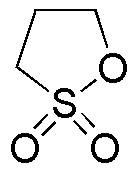1,3-Propanesultone is widely utilized in research focused on
- Electrolyte Solutions: It serves as a solvent in lithium-ion batteries, enhancing ionic conductivity and improving battery performance.
- Polymer Chemistry: This compound is used in the synthesis of sulfonated polymers, which are valuable in fuel cell technology due to their excellent proton conductivity.
- Pharmaceuticals: It acts as a building block in drug development, particularly for creating sulfonamide compounds that have antibacterial properties.
- Surface Coatings: The chemical is employed in formulating coatings that provide corrosion resistance and improved adhesion on various substrates.
- Analytical Chemistry: It is utilized as a reagent in chemical analysis, aiding in the detection and quantification of certain compounds.
General Information
Properties
Safety and Regulations
Applications
1,3-Propanesultone is widely utilized in research focused on
- Electrolyte Solutions: It serves as a solvent in lithium-ion batteries, enhancing ionic conductivity and improving battery performance.
- Polymer Chemistry: This compound is used in the synthesis of sulfonated polymers, which are valuable in fuel cell technology due to their excellent proton conductivity.
- Pharmaceuticals: It acts as a building block in drug development, particularly for creating sulfonamide compounds that have antibacterial properties.
- Surface Coatings: The chemical is employed in formulating coatings that provide corrosion resistance and improved adhesion on various substrates.
- Analytical Chemistry: It is utilized as a reagent in chemical analysis, aiding in the detection and quantification of certain compounds.
Documents
Safety Data Sheets (SDS)
The SDS provides comprehensive safety information on handling, storage, and disposal of the product.
Product Specification (PS)
The PS provides a comprehensive breakdown of the product’s properties, including chemical composition, physical state, purity, and storage requirements. It also details acceptable quality ranges and the product's intended applications.
Certificates of Analysis (COA)
Search for Certificates of Analysis (COA) by entering the products Lot Number. Lot and Batch Numbers can be found on a product’s label following the words ‘Lot’ or ‘Batch’.
*Catalog Number
*Lot Number
Certificates Of Origin (COO)
This COO confirms the country where the product was manufactured, and also details the materials and components used in it and whether it is derived from natural, synthetic, or other specific sources. This certificate may be required for customs, trade, and regulatory compliance.
*Catalog Number
*Lot Number
Safety Data Sheets (SDS)
The SDS provides comprehensive safety information on handling, storage, and disposal of the product.
DownloadProduct Specification (PS)
The PS provides a comprehensive breakdown of the product’s properties, including chemical composition, physical state, purity, and storage requirements. It also details acceptable quality ranges and the product's intended applications.
DownloadCertificates of Analysis (COA)
Search for Certificates of Analysis (COA) by entering the products Lot Number. Lot and Batch Numbers can be found on a product’s label following the words ‘Lot’ or ‘Batch’.
*Catalog Number
*Lot Number
Certificates Of Origin (COO)
This COO confirms the country where the product was manufactured, and also details the materials and components used in it and whether it is derived from natural, synthetic, or other specific sources. This certificate may be required for customs, trade, and regulatory compliance.


